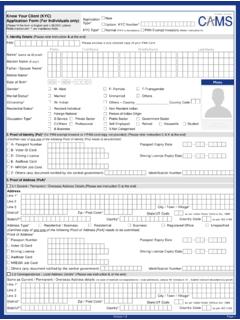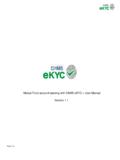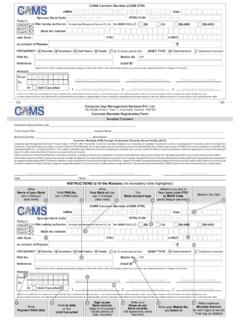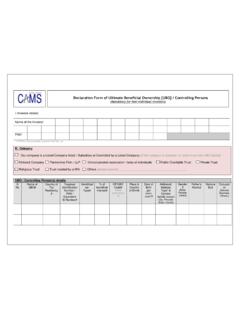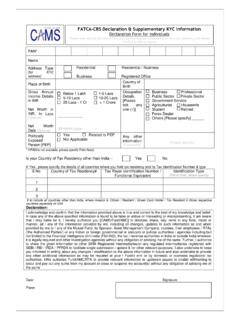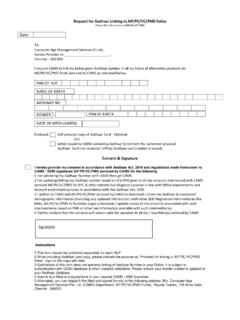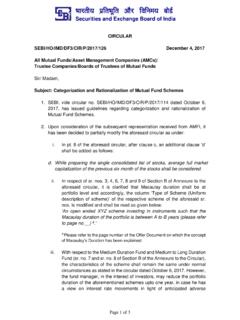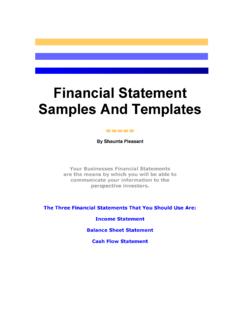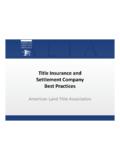Transcription of Investing & MF - Basics
1 Investing & MF -BasicsVersion to RecipientSlide 2 Investment Why Invest Some Key Concepts Inflation / Interest / Power of Compounding / Liquidity etc Asset Allocation Model Risk vsReward Different Investment OptionsMutual Fund Concept Why Mutual Fund Different Types of Funds Systematic Investment Tax Benefits Transaction Cost Hygiene FactorsCost of LivingWhy Investment?Confidential to RecipientSlide 3 Goals of LifeHow to achieve? Own House Children s Education Daughter s Marriage Peaceful Retirement Legacy for next generation Save part of the earnings Make the earnings sweat to expedite reaching the goalInvestments are required because Savings alone will not be enough to meet the goals Costs of inflationInvestment AmountNominal Value after 10 yearsReal Value after 10 yearsCashstored at 100Rs.
2 (at 5% inflation)Invested (6% return) 110(at 5% inflation)Inflation/InterestConfidential to RecipientSlide 4 Rate at which the value of currency decreases. Money can't buy the same amount of goods in the future. At 5% inflation, 1kg sugar that costs 40 rupees now will cost 65 rupees after 10 years. Rate charged by the lender to the borrower of money. Rate at which value of money invested increases. At 8% interest, 10,000 rupees invested today will value 22,000 rupees after 10 yearsInflationInterestInflation/Interest IllustrationPresent ValueAfter 10 years (without Investing kept idlein a locker)Value after 10 years (with Investing at 8%)Price of 1kg sugar with inflation 5%Rs. 40Rs. 65Rs. 65 Value of Rs. 1000 Rs. 1000Rs. 1000Rs. 2160 Quantity of sugar that can be bought1000/40 = 25 kgs1000/65 = kgs2160/65= kgsConfidential to RecipientSlide 5 Power of CompoundingConfidential to RecipientSlide 6 Compound interest is the interest on the Principal along with accumulated interest.
3 Money invested gives more money as it gets compounded Interest on interestTo unleash the powerof compoundingInvest earlyInvest regularlyInvest for long-term not the short-term Compounding interest is the greatest mathematical discovery of all time -Albert EinsteinIllustration Ramu and Krishna save Rs. 20000 at the end of each year. Ramu invested in a financial instrument that gives 10% returns and Krishna didn't want to take any risk and so he saved his money in savings bank that gives returns. After 10 years Krishna realizes the power of investment and starts to invest instead of to RecipientSlide 7 Money with RamuMoney with KrishnaAfter 10 yearsRs. 3,18,800Rs. 2,34,620 Money with RamuMoney with KrishnaAfter 20 yearsRs. 11,45,500Rs. 9,27,320 Total Money ,000 X 20 = Rs. 4,00,000Rs. 20,000 X 20 = Rs.
4 4,00,000 Total GainRs. 7,45,500Rs. 5,27,000 Risk vs Reward Potential returns increase with an increase in the risk associated. Low returns on Savings Accounts as risk is low. High returns from Stock Markets as risk is high. Risk appetite changes with the age, stage of life and other factors. A person who is young and single has more risk appetite. A person who has a family and in middle ages has less risk appetite. Investment should be made based on the risk appetite of the to RecipientSlide 8 Asset Allocation Model/PortfolioConfidential to RecipientSlide 9 In a portfolio, investments are made in two or more assets. To achieve a given level of returns with the minimum risk possible. Factors considered for Asset AllocationGoalInvestor s Risk ToleranceTime HorizonAsset Allocation for different investorsLiquidityConfidential to RecipientSlide 10 The ease at which an asset can be sold/exchanged without any significant drop in its price.
5 Transaction costs are higher for Low liquid Assets compared to High Liquid of the AssetExamplesTransaction Costs/BrokerageHighMoney,Cash in hand etcLowLowRealEstate, Automobiles etcHighCosts of TransactionConfidential to RecipientSlide 11 Investment AvenueAcquisitionCostLiquidationCostSavi ngsAccountNoNoGoldNoYesULIPsYes (high)Yes (high)Mutual FundsNoYes(<1 year)No (>1 year)EquityYesYesReal EstateYes (veryhigh)Yes (very high)Investment Options AvailableConfidential to RecipientSlide 12 PhysicalGold, Real estate, Commodities etcFinancialFDs, Post Office savings, insurance/provident/pension funds, Equity,Mutual FundsetcLowSavings account , , PPFs, Post Office Schemes etcMediumCompany Deposits, Mutual Funds, ULIPs, Gold, Properties etcHighStock Market Trading, ForexTrading etcLowReal Estate, Agricultural Land, AutomobilesetcMediumFixed Deposits, Gold etcHighMoney, Cash, Stocks, Mutual Funds Asset ClassRisk LevelLiquiditySuperiority of Equity ReturnsConfidential to RecipientSlide 13 Advantages associated with Equity InvestmentCapital AppreciationDividend EarningsRisk dilution through Diversification LiquidityTax Efficient (Dividend and Long-term Capital gains exempted)
6 Over a longer term, equity markets are one of the best avenues for investment as returns are highIllustrationConfidential to RecipientSlide 14 Investment AvenueAverage growth rateAmountInvested 10 years agoValue of the InvestmentnowSavings ,000Rs. 14,106 Fixed 10,000Rs. 18,335 Mutual Funds12%*Rs. 10,000Rs. 31,060 Stock Markets15%*Rs. 10,000Rs. 40,455* Based on last 10 years average; carries capital riskStage of Life -InvestmentConfidential to RecipientSlide 15 InsuranceSmall Savings Two WheelerHomeFour WheelerTax Saving SchemesEquityMutual FundsChild EducationGoldMutual FundsYoung AgeEarly Middle AgeEarly Young AgeMiddle AgeSecurity against UncertaintyTax Saving Plans and Early stages of Wealth BuildingWealth BuildingRetirement PlanningRisk of Individual InvestingConfidential to RecipientSlide 16 Robust Analysis not doneIndividual Investors have the Inability to DiversifySubject to misunderstanding risk and other costs related to the investmentKnowledge of the updates and need to be alert all the timePitfalls to be avoidedConfidential to RecipientSlide 17 Borrowing for Investing Interest on borrowed money should be paid back even during economic downturns when returns
7 Are tips on Investing Even experts can't time the markets properly. So such easy tips should be avoided by of Assets Buying of assets when their value is continuously falling should be clearly Understand the Investments One should clearly understand where their money is going. Investments should be made considering personal is a Mutual Fund?Confidential to RecipientSlide 18 Mechanism for pooling together savings of large number of investors For Collective InvestmentWith the objective of Capital AppreciationWhile ensuring LiquidityWhy Mutual Fund?Confidential to RecipientSlide 19 Professional ManagementEasy LiquidityReduction / Diversification of RiskReturn PotentialWell Regulated -Investor ProtectionLow Operating CostsTax BenefitDifferent types of SchemesConfidential to RecipientSlide 20 Investment ObjectiveOperationalClassification by Geography Income Schemes GrowthSchemes Balanced Schemes Tax Saving Schemes Sector Funds Index Funds Gilt Funds Money Market Funds Open Ended Schemes Closed EndedSchemes Interval Schemes Domestic Schemes Offshore SchemesMF Risk vsRewardConfidential to RecipientSlide 21 RETURNRISKL iquid FundsST Debt FundsGilt FundsDebt FundsBalanced FundsIndex FundsEquity FundsSectoralFundsSystematic Investments Method of Investing at regular intervals over a defined time frame.
8 Investor is able to get more number of units in the falling market and fewer unit when the price is high. Helps the investor to smoothen out the market fluctuations and the investment will be at a low cost over a period. Reduces the risk associated with timing the to RecipientSlide 22 Tax BenefitsConfidential to RecipientSlide 23 Income distributed by the scheme not taxable in the hands of the investor MF units exempted from Wealth Tax and Gift TaxCapital GainsEquity SchemesHeld for more than 12 months nilHeld for less than 12 months 15% Debt SchemesHeld for more than 12 months 20%Held for less than 12 months 30%Transaction Costs NilCost of acquisition NilCost of holding Nil (for > 1 year in case of equity and debt schemes) 1% (for <1 year holding)Cost of exit Financial Advisor needs to be paid by the investor Fair fee is required for quality adviceImplicit CostConfidential to RecipientSlide 24 Confidential to RecipientSlide 25 Hygiene Factors Mode of Holding.
9 Can be individual / joint / either or Preferable to have either or Need to have nominee (especially where the holding is individual) Updating contact details as and when a change occurs Address / bank details / mobile number / e-mail id Helps in eliminating fraudulent practices Monitoring investment at regular intervals Goal vsActual Performance vis a vis bench markMutual Fund Execution .. 1 Confidential to RecipientSlide 26 How do I make investment in MF? Decide which scheme to invest in Consult a Financial advisor to choose a scheme which is in line with your financial goal, risk appetite & time horizon Some schemes (like ELSS) have lock in period; also check exit load conditions PAN No & Bank details are a must to invest in MF In case of Micro SIP, PAN requirement is waived Submit the application along with chequeat the nearest CAMS office or the AMC office Investment can be made online using CAMS Online or the web services of the AMC Sample application form & guide for filling up available in the kit On units allotment, you will receive a statement of accounts showing units allotted, value and your personal detailsMutual Fund Execution.
10 2 Confidential to RecipientSlide 27 How do I redeem my investments? Decide which investment to redeem. Take the help of Financial Advisor if you have units in several schemes on the appropriateness of the timing and tax impact In case of schemes with lock in period, check whether the lock in period is over Submit the paper request at the nearest CAMS office or AMC office If there is a change in bank details, please take care to mention the same in the request. You will receive the proceeds directly in your bank account or by cheque. Statement of Accounts reflecting the units redeemed and revised holding will be issued Sample transaction slip available in the kit for referenceMutual Fund Execution .. 3 Confidential to RecipientSlide 28 Can I move my investment from one scheme to another? Yes, if both the schemes are from the same Fund House.
